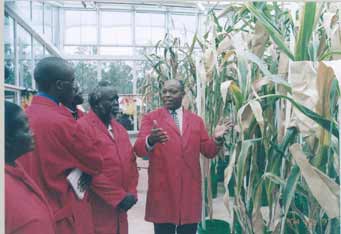Nairobi, Kenya
December 22, 2004
Highlighting the Insect Resistant Maize in Africa (IRMA)
project's mid-December annual meetings in Nairobi, Kenya, was
news that an application to conduct the first field planting of
transgenic Bt maize in Kenya would be submitted and likely
approved before year's end.
The application was indeed
approved during the week of 13 December by the Kenya
Agricultural Research Institute (KARI) Biosafety
Committee and was scheduled for consideration by the
National Biosafety Committee on 12 January 2005. If all
goes well, planting of Bt maize at the project's secure,
open quarantine site could go forward in February 2005.
Dr. Stephen Mugo of CIMMYT and Dr. Simon Gichuki of KARI
presented and defended the application for field
evaluation of maize containing the cry1Ab or cry1Ba (Bt)
genes.
The broader significance of the above is that it keeps
the IRMA project on track with its timetable to get
insect resistant maize out to Kenyan farmers. This
notable progress was but one of many activities reported
and considered at IRMA's annual project meetings held
8-10 December, which included the reporting/planning
meeting, the fifth annual stakeholders meeting, and the
steering committee meeting.
Reporting/Planning
Meeting |
 |
|
IRMA project manager,
Stephen Mugo (right), shows transgenic maize to farmers
in the biosafety greenhouse. The plants are being grown
for seed multiplication and for crossing in the
greenhouse with locally adapted maize varieties. |
Scientists from multiple
disciplines gathered together for the reporting/planning meeting
to hear from their colleagues about progress toward objectives
during the past year and to formulate integrated work plans for
the coming year. High points and achievements of 2004 included
the official launch of the level-2 biosafety greenhouse by the
Hon. Mwai Kibaki, President of Kenya; the importation of Bt
maize seed for testing in the biosafety greenhouse; the entry of
conventional IRMA maize varieties with insect resistance into
the Kenyan National Performance Trials (NPTs); completion of
surveys to determine available refugia across the nation's five
maize growing agro-ecozones; and analysis of urban consumer
acceptance surveys on GM crops.
Based on milestones achieved during 2004, ten theme groups put
together detailed work plans and proposed budgets for 2005, in
accordance with the recently revised project plan. The proposed
2005 activities chart a clear course forward, based on the
crucial field testing and analysis of IRMA's Bt maize varieties.
Equally significant is the strong possibility that IRMA maize
varieties with conventional resistance will be favorably
reviewed by the Kenya Plant Health Inspectorate Service (KEPHIS)
in national performance trials and pre-released in February 2005
for testing in farmers' fields under their management.
Fifth Annual Stakeholders Meeting
Approximately 75 people, in addition to a sizable media
entourage, participated in the IRMA stakeholders meeting.
Participants were first taken to the biosafety greenhouse
complex at KARI-NARL, where they inspected experiments on the
efficacy of Bt maize against Kenyan stem borers. They also saw
contained breeding activities aimed at producing Bt varieties
that are well adapted to Kenyan conditions and for producing
seed for further experimentation.
Following the greenhouse visit, stakeholders traveled to the
Nairobi Hilton Hotel, where Dr. Mpoko Bokanga, Executive
Director of the Africa Agriculture Technology Foundation (AATF),
chaired the meeting. Project Manager Stephen Mugo provided an
overview of IRMA activities during the past year, including the
new management structure for the project. He informed the
stakeholders that Phase II of the project will focus on getting
products to farmers, with a major effort to addressing
regulatory issues. The stakeholders also heard from
representatives of current and new IRMA partners: KARI, CIMMYT,
the Syngenta Foundation for Sustainable Agriculture, the
Rockefeller Foundation, and the African Agricultural Technology
Foundation (AATF).
Remarks by Dr. Joe DeVries of the Rockefeller Foundation
captured the gist of many of the brief addresses. He said that
since IRMA's inception, the Foundation has appreciated the
project's work on valuable technologies with the potential to
change the lives of farmers, and has been impressed by its
spirit of transparency and well intentioned communication
efforts. He stressed that promising or proven technologies must
be shared with poor farmers with the same or even greater
urgency as they are with the rich, and that the IRMA project
presents a great opportunity for Kenyan scientists to assess
novel technologies under their own conditions.
During the question and answer period, IRMA scientists fielded
questions from farmers, representatives of civil society,
university teachers and students, scientists, and others about
biosafety, regulatory and trade issues, and, as in the past, the
timetable for products to reach the field. A proceedings of the
meeting will be published in 2005 and made available to the
public.
Steering Committee Meeting
The IRMA steering committee met in a private session during the
final day of meetings to consider the proposed work plans and
budgets and discuss strategic issues. Renewal of the project for
Phase II and review of the project plan were high on the list of
priorities. Among the participants were Dr. Masa Iwanaga,
Director General of CIMMYT, Dr. Romano Kiome, Director of KARI,
Dr. Andrew Bennett, Executive Director of the Syngenta
Foundation, Dr. DeVries, and Dr. Bokanga. |